California duo create "world's first 3D-printed architecture"
News: California studio Smith|Allen has completed the world's first architectural structure using standard 3D printers (+ movie + interview).
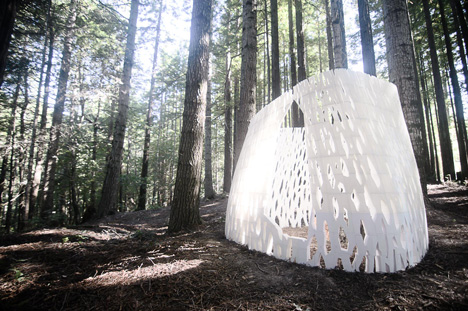
Called Echoviren, the 10 x 10 x 8 foot pavilion was completed last weekend. It consists of 585 individually printed components produced on seven Series 1 desktop printers made by Type A Machines.
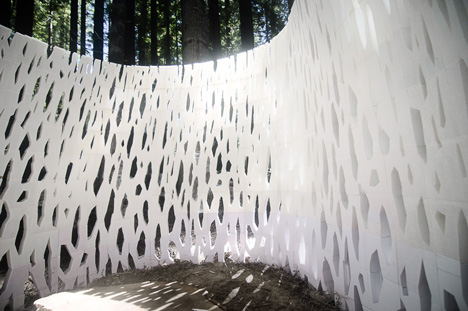
It took the printers two months and 10,800 hours to print the components, but just four days to assemble them on site.
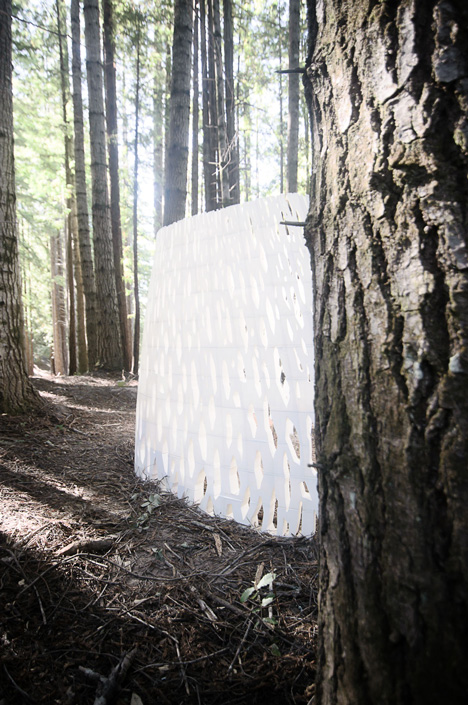
The components, each measuring up to 10 x 10 inches, were snapped together to create a perforated structure resembling an igloo with an opening at the top.
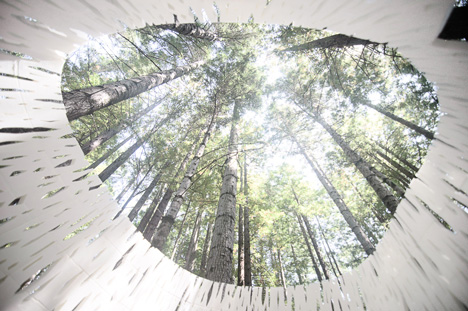
Each component is made of a plant-based PLA bio-plastic, meaning the structure will decompose over time, disappearing within 30-50 years. "As it weathers it will become a micro-habitat for insects, moss, and birds," the architects write.
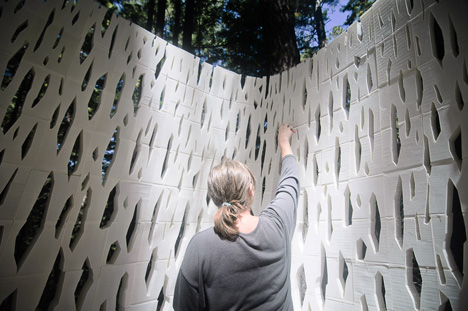
Artist Stephanie Smith and architect Bryan Allen of Smith|Allen built the structure in a redwood forest at Project 387, an arts residency programme in Mendocino County north of San Francisco.

"The texture [of the structure] is based on a study of the cellular forms of sequoia cells," Allen told Dezeen (see full interview below). "Their structure allows the trees to maintain huge amounts of strength with a minimum volume."
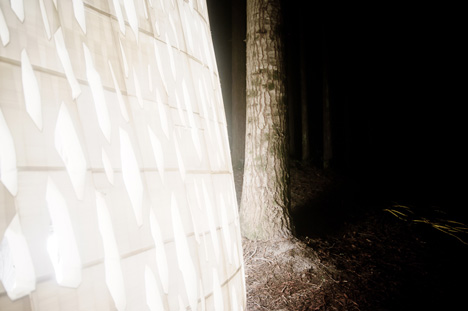
Allen added: "The overall form is driven by the structural requirements of building in PLA. The section is pyramidal so each of the walls is self supporting. As the structure is completed it becomes a compression structure with the top most layer forming a compression ring."

Architects have this year been racing to complete the first 3D-printed house, as we reported earlier this year. Projects in the pipeline include a looping two-storey dwelling by Dutch architects Universe Architecture and a fibrous single-story dwelling by UK studio Softkill. Meanwhile Amsterdam studio DUS Architects plan to create a canal-side house room by room.
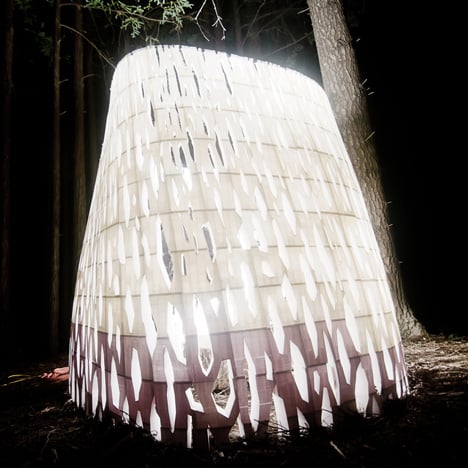
However Italian engineer Enrico Dini is credited with creating the first 3D-printed inhabitable structure using a D-Shape printer - a huge machine he invented himself that prints using a type of synthetic stone.
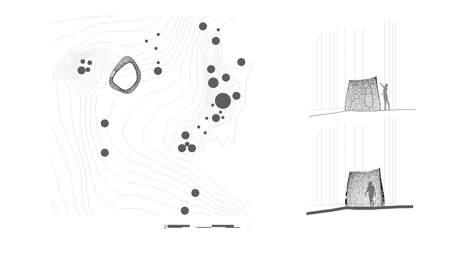
In 2009 Dini teamed up with designer Andrea Morgante to print a 3 metre-high prototype structure and the following year he worked with architect Marco Ferreri to print a single-room house modelled on a mountain dwelling. See our feature about 3D-printed architecture for more details.
We conducted an email interview with Bryan Allen of Smith|Allen about the project:
Marcus Fairs: Tell us about the type of printers you used.
Bryan Allen: We used 7 of the Type A Machines Series 1 printers. We've been working with some other types for a few years. I worked with Ron Rael at Emerging Objects and at Berkeley where we used ZCorp printers to develop new materials. The idea to make something huge has been around for a while but despite our efforts to use the ZCorp, the BFBs, or the Makerbots, it just wasn't possible or it was prohibitively expensive. The Series 1 made it possible to build large prints reliably and with the price drop in PLA, building something big became a reality.
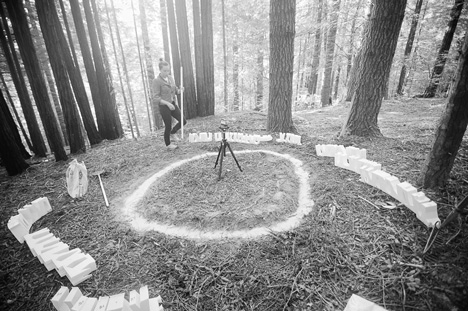
Marcus Fairs: What does Echoviren mean?
Bryan Allen: The name Echoviren comes from a reference to the coastal redwood, it's Latin name is sequoia sempervirens. Translated roughly that's 'always alive' or 'always growing'. The Echoviren is a technological echo, a reflection, and specter of life and of the forest. It evokes the essence of its site in the forest and mirrors it in a deliberately artificial method. Although we consider this forest primeval and natural, in reality its a highly controlled and modified environment, the forest has been logged and even before recorded history it was cultivated. Echoviren highlights that palimpsest, a forest landscape that has been written over many times, continually changed and grafted onto.
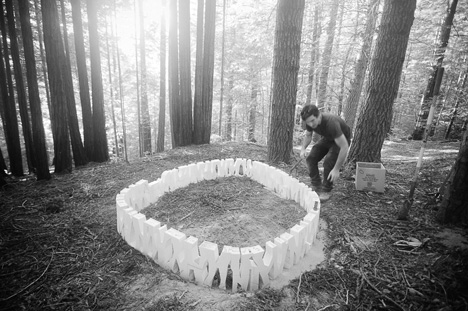
Marcus Fairs: What are the form and texture of the structure based on?
Bryan Allen: The texture is based on a study of the cellular forms of sequoia cells. Their structure allows the trees to maintain huge amounts of strength with a minimum volume. This form also naturally works well on FDM-style printers. Their ability to print cellular infill structures on the interior of parts fits in with a macro scale cellular tessellation scheme. The perforations form a gradient of size drawing the viewers vision up and through the occulus.
The overall form is driven by the structural requirements of building in PLA. The section is pyramidal so each of the walls is self supporting. As the structure is completed it becomes a compression structure with the top most layer forming a compression ring. The PLA components are strong in compression and the pyramidal section coupled with a compression ring makes the structure tend towards stability. In the XY the components are connected via a dovetail joint, in the Z the layers fit together with a pin and socket.
Marcus Fairs: How did you get started with 3D printing?
Bryan Allen: When my partner and I graduated from School we lost our access to the tools that had allowed us to make,design, and to create things. We were faced with a choice: go into an office and slave over CAD drawings for a couple years working on someone else's projects until I could get licensed, or to go it on our own. Getting the printers made it possible for us to actually make a go of doing what we really wanted to do: creating large scale installations, sculpture, and architecture.
We first attempted to make a small scale aggregation called Xylem at the end of 2012. That piece was 4x4x3' and after we completed it we thought well, what if we go bigger? We bought more printers, put them in our studio and got to work. We applied to Project 387 for funding and for the site, after we were accepted we began construction.
Marcus Fairs: What's new about this project that hasn't been done before?
Bryan Allen: I think the fundamental breakthrough in this project is that of aggregation as a construction system. So many of the 3D printed architecture projects that have been proposed are based on building large scale printers which is a huge barrier in and of itself. By utilizing Rhino and grasshopper with consumer-grade, easily available desktop 3D printers we were able to make this thing in (relatively) small, precise, individual components. After all architecture is about assemblage, it's about how to organize connections, details, and joints. To design a 3D printed architecture requires a fundamental rethinking of how we design: there are new details, systems, and processes that open the door to the huge potential of 3D printed architectures.
Marcus Fairs: What will you work on next?
Bryan Allen: So next we are going to be working on a retail interior in Oakland California. We are hoping to build a large scale urban intervention in San Francisco at the beginning of next year. We are also closely involved with Type A Machines and hope to be designing pavilions and other structures for their office and events in the future. We want to continue to grow the scale and scope of our projects. We want to find the limit of what is possible within the disruption 3D printers have created. We want to incorporate more intensive systems into 3D printed constructions like HVAC, lighting, etc, as well as make spaces for more permanent dwelling.
Marcus Fairs: What's next for 3D printing?
Bryan Allen: There are some new printers and materials coming out that allow designers who don't have the resources of a huge institution to begin to realize their creations and push the envelope of architecture in general. To us the 3D printer is right on the cusp of transitioning from a toy to a tool, it can make real things, real design, and real architecture.
Marcus Fairs: What is Project 387?
Bryan Allen: Project 387 (www.project387.com) is a multidisciplinary residency program in its inaugural season. Located in rural Mendocino Country, California Project 387 has offered six artists an opportunity to develop their proposed projects in the quiet of giant redwoods. This year’s selected residents are: Smith|Allen Studio [Bryan Allen and Stephanie Smith] (Oakland CA), Rich Benjamin (Brooklyn NY), Claudia Bicen (San Francisco CA), Sean McFarland (San Francisco CA), and Robert Wechsler (Glendale CA).
Project 387 provides community-based living and working experience to artists in all career stages. The residency is a unique opportunity to dive into the creative process in a focused, exploratory and rigorous manner while removed from the clamor of urban distractions.
Here's some more info about the project from Smith|Allen:
Echoviren, the worlds first piece of full scale 3D printed inhabitable architecture
Smith|Allen participated in the Project 387 Residency, located in Mendocino County from August 4-18, 2013. In the heart of a 150-acre redwood forest, Smith|Allen has created a site responsive, 3D printed architectural installation (the largest of its kind): Echoviren. The project merges architecture, art and technology to explore the dialectic between man, machine and nature. The Project 387 open house and reception was Saturday, August 17.
Spanning 10 x 10 x 8 feet, Echoviren is a translucent white enclosure, stark and artificial against the natural palette of reds and greens of the forest. Walking around and within the structure, the viewer is immediately consumed by the juxtaposition, as well as uncanny similarity, of natural and unnatural: the large oculus, open floor, and porous surface framing the surrounding coastal landscape.
This artificial frame draws the viewer up from the plane of the forest, through a forced perspective into the canopy.
Echoviren was fabricated, printed, and assembled on site by the designers. Through the use of parametric architectural technologies and a battery of consumer grade Type A Machines desktop 3D printers, Smith|Allen has constructed the world’s first 3D printed, full-scale architectural installation. Made of over 500 unique individually printed parts, 7 3D Printers ran constantly for 2 months for a total of 10800 hours of machine time.
The structure was assembled though a paneled snap-fit connection, merging individual components into a monolithic aggregation. From breaking ground to finish the prefab 3D printed construction technique required for only 4 days of on site building time.
Entirely composed of 3D printed plant based PLA bio-plastic, the space will decompose naturally back into the forest in 30 to 50 years. As it weathers it will become a micro-habitat for insects, moss, and birds.
A graft within the space of the forest, Echoviren is a space for contemplation of the landscape, of the natural, and our relationship with these constructs. It focuses on the essence of the forest not as a natural system, but as a palimpsest. The hybridized experience within the piece highlights the accumulated iterations of a site, hidden within contemporary landscapes.
Echoviren exposes an ecosystem of dynamic natural and unnatural interventions: the interplay of man and nature moderated by technology.
Location: Project 387 Gualala, California
Manufactured by: Smith|Allen
Involved companies: Type A Machines
Commissioned by: Project 387